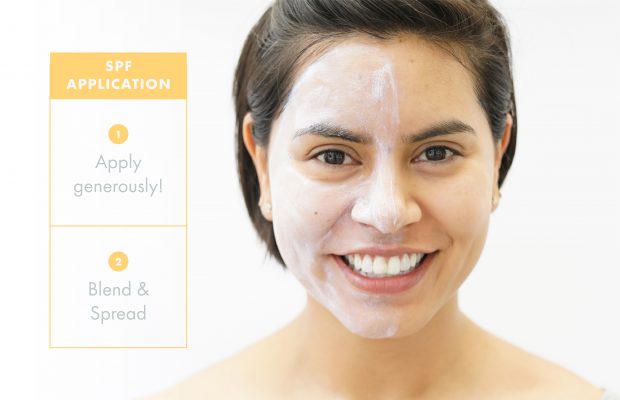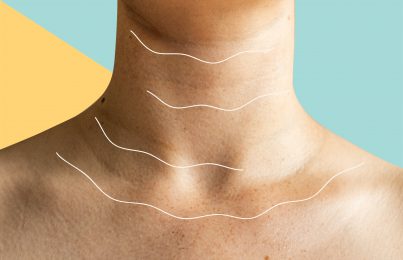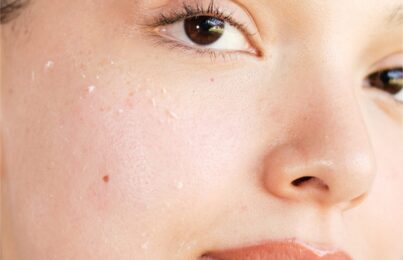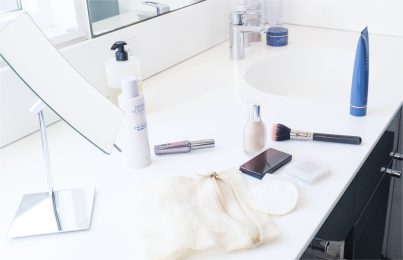Updated 05/24/23. Of all the skincare products to get right in your routine, sunscreen is the most important. After all, it’s the best preventative aging product that we have, and using it every single day, no matter rain or shine, is the key to keeping your skin healthy and youthful-looking.
What many people don’t know, though, is that the SPF number isn’t necessarily a guarantee of proper protection. Rather, it’s how generously and meticulously you apply it. Keep reading to learn how to apply sunscreen to your face and neck to ensure proper protection from harmful UV rays.
How to Properly Apply Sunscreen to the Face and Neck
Step 1: Start With Your Face
After using a cleanser, toner, and an antioxidant serum with vitamin C (like the Vitamin C&E Treatment), take a quarter-size amount of sunscreen and rub it together with your fingertips. Start by applying it to the bridge of your nose, then carry it down the sides of your nose, working outwards towards your ears. From there, move to the lower half of your face, and finally, to your forehead. You’ll want to make sure that you’re very thorough in your application. Make sure you’re extending your sunscreen all the way up and out to your hairline. This will ensure that every inch of your skin is protected.
You should be applying a generous amount of sunscreen (like the amount shown in the photo above). Try to remember to use a quarter-size amount for your face, alone. Your neck and chest require a separate application (but more on that in a minute).
Note: The reason I suggest spreading the sunscreen in your fingers first, versus putting dollops onto your face and then spreading it out, is simply that you’re more likely to get an even application when you spread it out in your fingers first.
Step 2: Apply It to Your Ears
Many people forget to apply sunscreen to their ears, even though they’re often exposed to the sun for long periods of time—especially if they’re being active and tying their hair back. When applying sunscreen to your ears, use a generous amount and make sure you’re getting an even application.
Step 3: Move on to Your Neck
For this area, you’re going to want to use an additional nickel to quarter-size amount of sunscreen (the key word, here, is additional). Many people make the mistake of using whatever is left on their fingers and rubbing it haphazardly over their necks. I can assure you that if you do this, your neck will not be properly protected. It’s so important to do a separate application.
When applying sunscreen to the neck, start at the front and move in upward strokes from your collar bones all the way up to your chin. Then, work sideways, extending all the way to the hairline on the back of your head. This will ensure that you are properly and evenly covering the entire exposed area.
Step 4: Don’t Forget Your Chest
If you’re going to be wearing an item of clothing that allows the chest to be exposed to the sun, apply a generous layer of SPF there as well. Again, a separate application is important for proper coverage. Just be sure to let it dry before getting dressed.
Step 5: Finish with SPF-Infused Makeup
Ideally, you’ll want to use mineral-based makeup with sunscreen on top of your basic sunscreen. This will offer additional sun protection. In fact, I wear makeup every single day and recommend my clients do too, for this exact reason. (Read more about how makeup can actually benefit the skin).
Step 6: Reapply Throughout the Day
While learning how to apply sunscreen is important, you also need to remember to reapply it. Ideally, you should be reapplying SPF every two hours. But how does that work if you wear makeup or you’re out and about and you don’t want to wash your face and start all over? Easy. Check out four ways to reapply sunscreen over makeup (and the pros and cons of each).
There you have it! Now you know how to apply sunscreen to your face and neck. Complete this process each morning and repeat it 365 days a year. Trust me—your skin will be all the better for it and you’ll dramatically minimize premature signs of aging.
Next, read up on five skincare mistakes that could be making your sunscreen less effective.
Celebrity Esthetician & Skincare Expert
As an esthetician trained in cosmetic chemistry, Renée Rouleau has spent 35 years researching skin, educating her audience, and building an award-winning line of products. Her hands-on experience as an esthetician and trusted skin care expert has created a real-world solution — products that are formulated for nine different types of skin so your face will get exactly what it needs to look and feel its best. Trusted by celebrities, editors, bloggers, and skincare obsessives around the globe, her vast real-world knowledge and constant research are why Marie Claire calls her “the most passionate skin practitioner we know.”




Comments:
Hello Renee. What do you recommend for hyperpigmentation you don’t respond to anything but getting worst. Thanks
Posted By: NANCY MULFORD |
Hello! To fade acne scaring it is important to have a balance of exfoliation, to remove discolored cells, and protection, to prevent new scars from forming. Having appropriate exfoliation for your skin type in a mix of acids, enzymes, and scrubs will be key for lifting away pigmentation. I have a specialty treatment called Post-Breakout Fading Gel which uses a combination of exfoliating acids and brighteners to fade acne scars up to 50% faster. The Triple Berry Smoothing Peel is a wonderful exfoliating treatment for all skin types too!
Posted By: Ella Stevenson |
Can you recommend sunscreen for lips or a lip balm with SPF? I’ve used Juice Beauty and Sun Bum mineral lip screens but the zinc completely dries out my lips! Any favorites??
Posted By: Kat |
Hi Kat! Try Supergoop lip balm with SPF. It’s a nice hydrating formula that doesn’t dry out my lips 🙂
Posted By: Renée Rouleau |